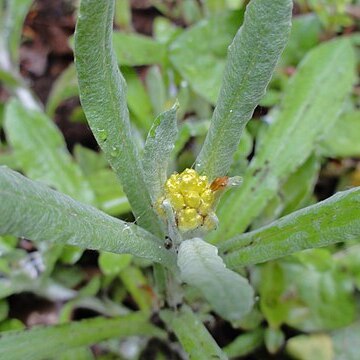Herbs, annual, erect. Stems branched from base, 2-10(-40) cm tall, gray or dull gray-green villous. Basal leaves short lived, withering at anthesis; cauline leaves dull gray-green silky on both surfaces, linear to narrowly elliptic, 1.5-7 × 0.2-0.4 cm, margin entire or wavy, villous. Capitula initially in continuous or interrupted spiciform arrays 2-4 cm × 8-12 mm, later in loose paniculiform arrays 4-18 cm, lanate at base only; subtending leaves 1-3, 1-6 cm. Outer phyllaries ovate, 2-3 × ca. 1 mm, apex shortly acute to acuminate; inner ones brownish, sometimes tinged purplish, lanceolate, 3-3.2 × ca. 0.8 mm, scarious toward margin, apex obtuse to acute, mucronate. Outer florets many, filiform; corolla 2.1-2.3 mm. Central florets 2 or 3; corolla 1.6-1.7 mm. Achenes elliptic, ca. 0.5 mm. Pappus ca. 2.5 mm, connate at base into a ring. Fl. May-Jul.
Annual herb, stems simple or sub-simple, erect, up to c. 300 mm tall, thinly grey silky-woolly, leafy throughout. Leaves up to 47 x 7 mm, becoming smaller upwards, oblanceolate, uppermost oblong-lanceolate, passing into long, narrow inflorescence bracts, both surfaces closely grey silky-woolly. Heads c. 3 x 2 mm, in small glomerules or short spikes racemosely arranged. Involucral bracts in c. 3 series, pellucid, tips tinged light brown, woolly at the base. Flowers c. 120 ('female'), 3, ('bisexual'), whitish. Achenes 0.5 mm long, minutely hairy, myxogenic. Pappus bristles many, scabridulous, bases fused in a smooth ring.

